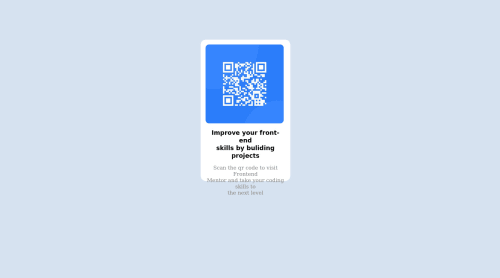qr-code using html and css

Please log in to post a comment
Log in with GitHubCommunity feedback
- @Hassiai
Replace the div with the main tag to fix the accessibility issues. click here for more on web-accessibility and semantic html There is no need for the <br> in the html.
To center the div on the page using flexbox or grid instead of a margin, add min-height:100vh; display: flex; align-items: center: justify-content: center; or min-height:100vh; display: grid place-items: center to the body.
To center the div on the page using flexbox: body{ min-height: 100vh; display: flex; align-items: center; justify-content: center; }To center the div on the page using grid: body{ min-height: 100vh; display: grid; place-items: center; }For a responsive content, there is no need to give the div a height value, replce the width of the div with
max-width, give it a fixed padding value and increase the max-width.max-width: 320px padding:16px.Give the img a max-width of 100% for a responsive width instead of an inline-styling with a width and height value.
Give h1 and p the same font-size of 15px, and the same margin-left, margin-right and margin-top values. Give p a margin bottom value.
Use relative units like rem or em as unit for the padding, margin, width values and preferably rem for the font-size values, instead of using px which is an absolute unit. For more on CSS units Click here
Hope am helpful.
Well done for completing this challenge. HAPPY CODING
- @MelvinAguilar
Hello 👋. Congratulation on successfully completing your first challenge 🎉 ! !
I have some recommendations regarding your code that I believe will be of great interest to you.
- Change the name of the file
qr.htmltoindex.htmlto access the solution only using https://ayupaul.github.io/qr-code/. by default when typing a url the fileindex.htmlis displayed and that's why you had to manually write the file name. This name for the main document is a standard.
HTML 🏷️:
- Wrap the page's whole main content in the
<main>tag.
- The <br> tag is often used to create line breaks, but it doesn't convey any semantic meaning. When a screen-reader reads the text, it will break the flow of reading at the line break tag, which can be confusing for users. More information here.
Alt text 📷:
- The
altattribute should not contain the words "image", "photo", or "picture", because the image tag already conveys that information.
-
The
altattribute should explain the purpose of the image. Uppon scanning the QR code, the user will be redirected to the frontendmentor.io website, so a betteraltattribute would beQR code to frontendmentor.ioIf you want to learn more about the
altattribute, you can read this article. 📘.
CSS 🎨:
- Instead of using pixels in font-size, use relative units like
emorrem. The font-size in absolute units like pixels does not scale with the user's browser settings. Resource 📘.
- For better readability, consider changing the color of the paragraph element to a darker hue, such as
hsl(220deg, 15%, 55%). This will increase contrast and make the text more legible against the background.
CSS Reset 🔄:
-
You should use a CSS reset. A CSS reset is a set of CSS rules that are applied to a webpage in order to remove the default styling of different browsers.
CSS resets that are widely used:
I hope you find it useful! 😄 Above all, the solution you submitted is great!
Happy coding!
- Change the name of the file
Join our Discord community
Join thousands of Frontend Mentor community members taking the challenges, sharing resources, helping each other, and chatting about all things front-end!
Join our Discord